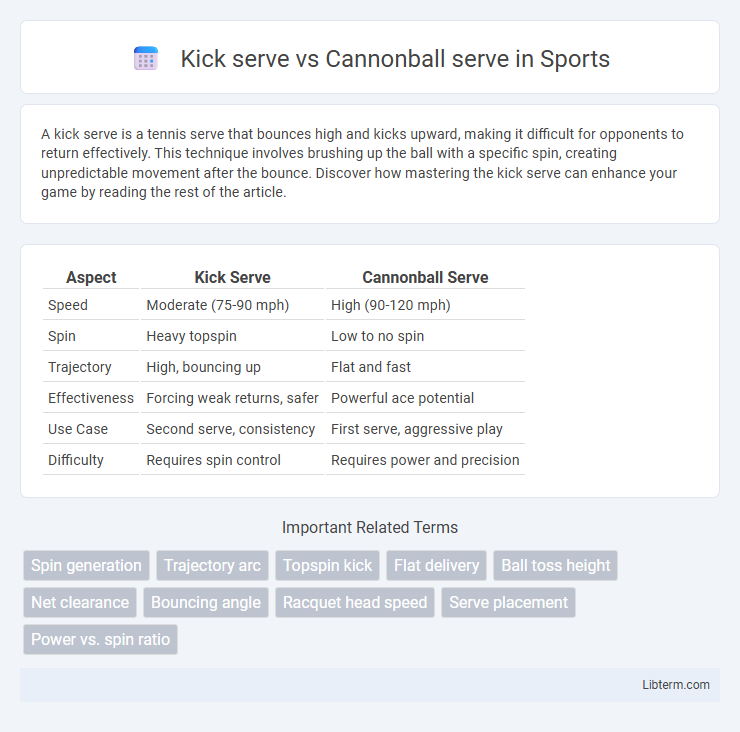A kick serve is a tennis serve that bounces high and kicks upward, making it difficult for opponents to return effectively. This technique involves brushing up the ball with a specific spin, creating unpredictable movement after the bounce. Discover how mastering the kick serve can enhance your game by reading the rest of the article.
Table of Comparison
| Aspect | Kick Serve | Cannonball Serve |
|---|---|---|
| Speed | Moderate (75-90 mph) | High (90-120 mph) |
| Spin | Heavy topspin | Low to no spin |
| Trajectory | High, bouncing up | Flat and fast |
| Effectiveness | Forcing weak returns, safer | Powerful ace potential |
| Use Case | Second serve, consistency | First serve, aggressive play |
| Difficulty | Requires spin control | Requires power and precision |
Introduction to Kick Serve and Cannonball Serve
The Kick Serve is a tennis serve characterized by its high bounce and heavy topspin, making it effective for pushing opponents far behind the baseline. The Cannonball Serve delivers immense power and speed with a flat trajectory, aiming to overpower the receiver through sheer velocity. Both serves are essential tools in a player's arsenal, offering distinct tactical advantages depending on playing style and court conditions.
Definition and Mechanics of the Kick Serve
The kick serve is a type of tennis serve characterized by its high bounce and topspin, achieved by brushing up the back of the ball with an upward racquet motion. This spin causes the ball to jump off the court surface, making it difficult for opponents to return effectively. In contrast, the cannonball serve is a flat, powerful serve aimed at speed and placement rather than spin.
Definition and Mechanics of the Cannonball Serve
The Cannonball serve is a powerful tennis serve characterized by its high velocity and flat trajectory, designed to overwhelm opponents with speed. Mechanically, the Cannonball serve employs a rapid, explosive motion with a strong wrist snap and minimal spin to maximize ball speed, contrasting with the Kick serve's upward brushing action that imparts heavy topspin and greater bounce. This serve relies on precise ball toss placement and swift racquet acceleration to generate a direct, penetrating shot that aims to shorten rallies and force weak returns.
Key Differences Between Kick and Cannonball Serves
The kick serve uses heavy topspin and a high-rising trajectory to bounce deep, making it effective for pushing opponents back and setting up baseline rallies, while the cannonball serve relies on flat, powerful hits with minimal spin for maximum speed and an aggressive, low bounce. Kick serves typically have slower speeds around 60-75 mph but generate unpredictable bounce, and cannonball serves can reach velocities exceeding 90 mph, focusing on outright points or aces. The technical execution differs as well, where the kick serve involves a high toss behind the head and a brushing upward motion, contrasting with the cannonball's flatter toss and explosive overhead swing.
Advantages of Using a Kick Serve
The kick serve offers a higher margin of safety due to its increased net clearance and unpredictable bounce, making it ideal for consistent second serves in tennis. This serve generates significant topspin, which aids in controlling ball placement and reducing double faults, especially under pressure. Players leveraging the kick serve often gain strategic advantages by forcing opponents into defensive positions with its high, deep trajectory.
Advantages of Using a Cannonball Serve
The cannonball serve generates immense power and speed, making it difficult for opponents to anticipate and return effectively, thus increasing the chance of winning points outright. Its flat trajectory reduces time for opponents to react, enhancing offensive pressure during matches. Utilizing the cannonball serve leverages raw force to dominate service games, particularly useful on faster court surfaces.
Common Situations for Each Serve Type
Kick serves excel in high-bouncing situations on clay and hard courts, forcing opponents to hit weaker returns by pushing them back behind the baseline. Cannonball serves dominate on faster surfaces like grass, delivering powerful, flat shots that generate minimal bounce and rush opponents off the court. Players often choose kick serves when facing aggressive returners and cannonball serves to seize quick points against defensive players.
Player Profiles: Who Uses Kick vs Cannonball Serves
Players who rely on the kick serve often include baseline strategists and defensive players seeking to generate high bounce and disrupt opponents' timing, such as Rafael Nadal and Simona Halep. In contrast, the cannonball serve is typically utilized by aggressive, power-focused servers like John Isner and Serena Williams, who prioritize speed and immediate dominance on the point. Serve selection reflects individual playing styles: kick serves excel in spin and control, while cannonball serves maximize raw pace and intimidation.
Tips for Mastering Both Serves
Mastering the kick serve requires focusing on brushing up the ball with high racket speed and pronation to generate topspin, ensuring consistent bounce and control. For the cannonball serve, emphasize explosive power from the legs and a firm wrist snap to produce velocity and flat trajectory, maximizing serve speed. Practicing proper foot positioning, maintaining balance during the swing, and incorporating targeted drills enhance efficiency and precision for both serve types.
Choosing the Right Serve for Your Game
Choosing the right serve depends on your playing style and court position; the kick serve offers high bounce and spin, ideal for baseline players seeking control and consistency, while the cannonball serve delivers raw power and speed, perfect for aggressive players aiming to dominate with force. Assess your strengths: use the kick serve to create difficult returns through heavy topspin, or opt for the cannonball serve to apply pressure with sheer velocity. Tailoring your serve selection enhances match strategy and capitalizes on your unique skill set.
Kick serve Infographic

 libterm.com
libterm.com